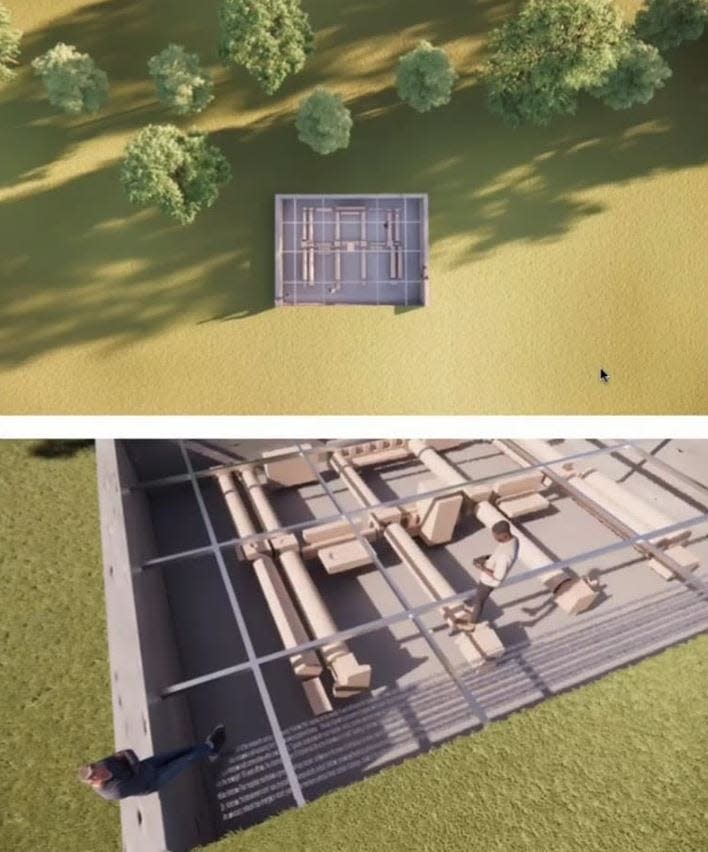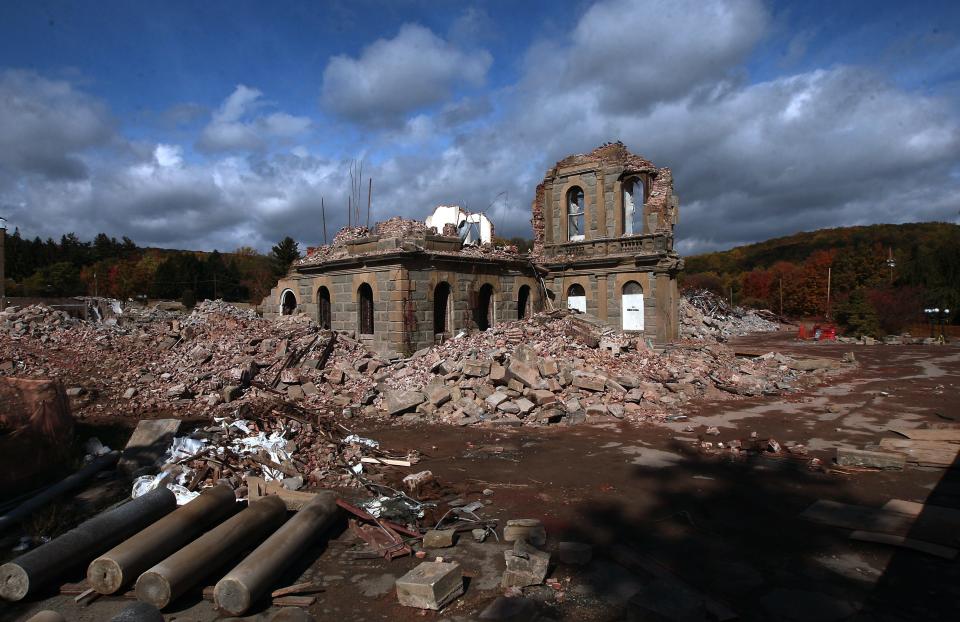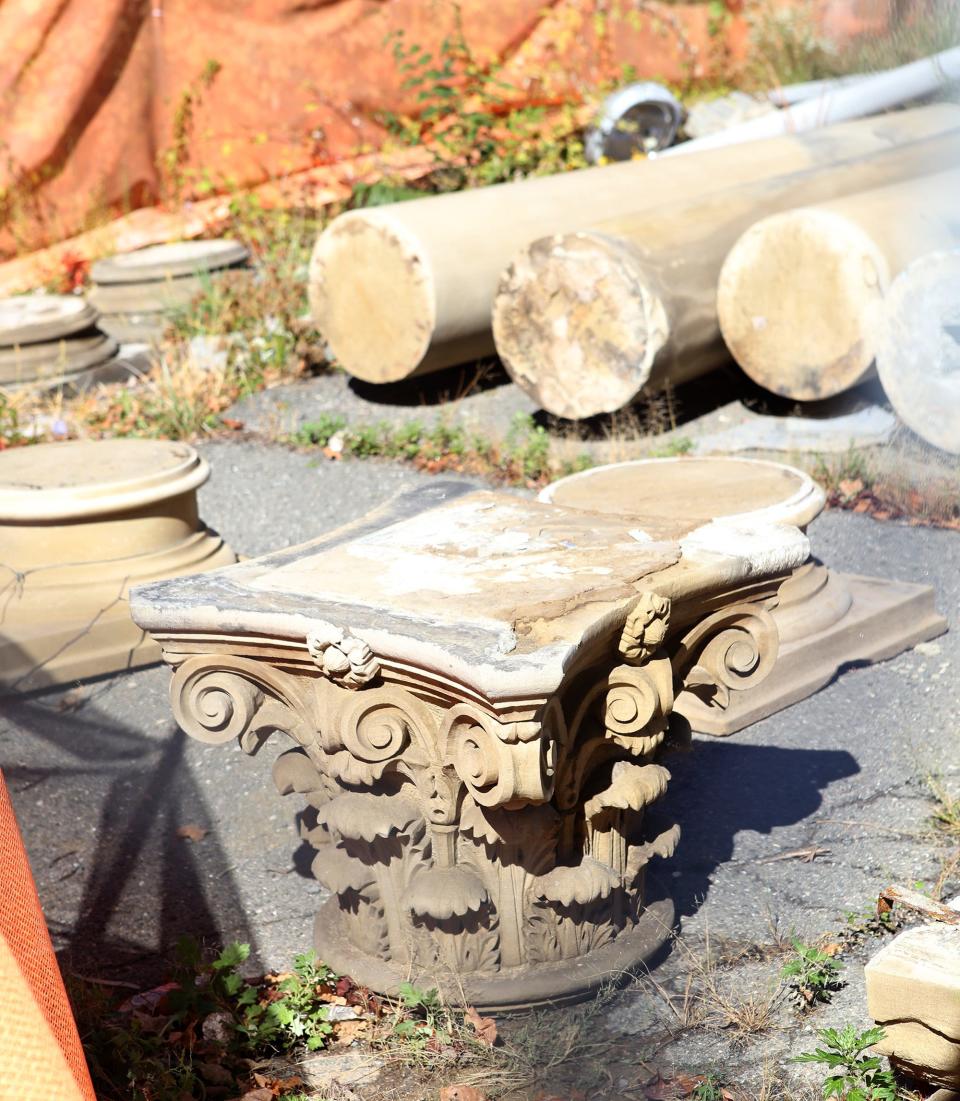Memorial plans revealed to preserve monumental history of Greystone Park hospital
When the wrecking ball finally claimed the crumbling Greystone Park Psychiatric Hospital in 2015, many who mourned the loss of the enormous building in Parsippany were comforted that remnants of the historic structure had been preserved for a future memorial.
Eight years later, that initiative is finally gaining momentum, with a relative of Greystone's 19th-century designer taking a lead role, along with his students from the elite Parsons School of Design in New York.
"During the past few years, many projects including this one were slowed down," said Robert Duffy, a preservation expert and member of a grassroots group working on the Greystone memorial with the Morris County Park Commission.
"Fast-forward to now and we are holding meetings regularly with the commission and other agencies to finalize the design of the memorial and start building it," he said.
The timeline is ambitious: Organizers don't have a final design or local approvals, but they hope to break ground in 18 to 24 months. But Duffy and others in the Greystone Park memorial group said Park Commission Chairman David Helmer is helping to facilitate the project. Planners hope to complete work in time for the former building's 150th anniversary in 2026.
"During the next two years and until completion, we will be working hard," Duffy said. "This includes doing multiple events to raise awareness and money. There is even talk of doing a 'Greystone Day' on the site."
Greystone memorial designs unveiled
The group recently unveiled conceptual designs for the memorial, created by the Parsons students.
The students' instructor is Robert Kirkbride, a relative of physician Thomas Kirkbride, whose revolutionary approaches to treating mental health were incorporated into Greystone when it opened in 1876. Similar "Kirkbride Plan" facilities were built throughout the United States at the time.
"When I was asked to be involved in the design development of the memorial, I said 'absolutely.' That's very much part of my training and background as well as my teaching," said Kirkbride, a professor of architecture and product design.
At Parsons, he devoted an entire class semester to the adaptive reuse of Kirkbride buildings. As part of that study, Kirkbride tasked junior architectural design students to design memorials for Greystone and the Hudson River State Hospital in Poughkeepsie, New York.

The resulting proposals range from plantings that would outline the Parsippany building's massive footprint to erecting marble columns rescued from the building's iconic facade (the imposing structure has been featured in several TV shows and films). The columns would buttress a display space for the other preserved fragments of the hospital. Another design would display preserved elements below ground, beneath a transparent cover on which visitors could walk to view the relics.
"The way the students designed the memorials was remarkable," Kirkbride said. "There was pure joy in seeing these students get their heads around the significance of these buildings, with their difficult histories, and how to take these fragments and breathe new life into them to help remember and memorialize the patients, the practitioners, the nurses, the staff — everyone who invested themselves into trying to make these places healing places."
Part of a mental health revolution
Greystone was part of a national movement in the 19th century to improve treatment of the mentally ill by replacing the cramped and grim "lunatic asylums" of the past with more welcoming and spacious campuses. The five-story, 675,000-square-foot "Kirkbride building" at the center of the Greystone complex was believed to have the largest concrete foundation of any building in the country before the construction of the Pentagon in 1941.
In designing the Parsippany property, architect Samuel Sloan followed the Kirkbride Plan, which sought to treat patients not only through medical science, but by the environment where they were kept.
The main building included 40 wards, split into separate wings for men and women. Erected on a 743-acre campus in what is now Central Park of Morris County, Greystone became a self-sustaining community, with its own farms, a police force, a post office, a golf course and a train station.
"The students really understood the intertwining of the Kirkbride Plan," Robert Kirkbride said of his forebear's vision. "My relative intended to knit together landscape and building, and those two aspects of being inside and outside were so important to the therapeutic experiences."
Protests: Hundreds march to save Greystone ahead of demolition
Almost a century later, the hospital was the setting for a historic if somber moment in music history. Woody Guthrie famously spent several years at Greystone in the early 1960s as he struggled with Huntington's disease. A young Bob Dylan made a pilgrimage to the facility in 1961 to meet his musical hero there.
Guthrie's daughter, Nora, who used to visit her father at Greystone with her brother, Arlo, returned to Morris County in 2014 for a presentation about her father's stay.
"I remember it very well," Nora Guthrie said. "The feeling of driving up to this ... city.
"Like it was another planet, occupied by people only in white, and patients."
Decline and destruction
In the latter half of the 20th century, overcrowding and a new emphasis on psychotropic drugs over institutionalization led to Greystone's decline. The state allowed buildings to deteriorate, and reports of patient abuse and escapes continued to surface. In the 90s, then-Gov. Christine Todd Whitman ordered the site closed by 2003. It was replaced with a new Greystone Park Hospital that opened on the site in 2008.

Public protests, legal challenges and rallies aimed at saving the historic main building followed, but to no avail. A new governor, Chris Christie, dismissed several formal expressions of interest by developers eager to repurpose the structure as too expensive or impractical. A $34 million demolition began in late 2014.
The final bricks came down in October 2015. The 165 acres of the land cleared by the razing were annexed into the county park, now home to athletic fields and a dog run.
Robert Kirkbride, the Parsons professor, also is the spokesperson and a founding trustee for PreservationWorks, a national nonprofit advocating for the preservation and reuse of Kirkbride Plan hospitals. The Greystone Memorial Group is a satellite of that organization.
"There are about 36 [Kirkbride buildings] left in the United States and Canada out of over 75," he said, "and many of those 36 are actually at the brink."
Sixteen of the standing Kirkbrides are still in their original use, though several are in "severe disrepair," including Trenton Psychiatric Hospital, Kirkbride said.
Endangered: These NJ landmarks made the list of 10 Most Endangered Historic Places
"I've been working over the past several years to really voice what we lost at Greystone and to try to help other communities avoid that same calamity," he added.
Twelve Kirkbrides have been rehabilitated or repurposed or are being renovated for community use, including former hospitals in Ohio, Alabama and South Carolina. Two more are "currently vacant and at risk," Kirkbride said, one in Minnesota and another in Sydney, Australia.
"We've developed stigmas [regarding the historic treatment of the mentally ill] around the buildings, but the buildings need to be separated from the stigma," he said. "That's the lazy route out for politicians and developers, who bear grudges and point them towards buildings rather than ourselves."
Pieces of history preserved

While the physical remembrance remains in the works, Greystone's legacy also has been documented in book form and an oral history project. Rusty Tagliareni, co-author with Christina Mathews of "Images of America: Greystone Park Psychiatric Hospital," is part of the group working on the memorial project. Tagliareni and Mathews are also working on a "Greystone's Last Stand" documentary.
Tagliareni, Mathews, Duffy and Kirkbride worked together to convince the Greystone demolition contractors to preserve 80 pieces of the distinctive architectural elements from the Greystone facade, including 16 marble entry columns, decorative moldings and other ornamental details to be incorporated into the final design.
"They were very kind to show us some grace," Duffy said of the East Hanover-based Northstar Contracting Group. "They understood the importance of those artifacts."
For now, Greystone's remnants have been secured in an existing facility on the grounds, sheltered from the elements until they are needed, Duffy said.
Groundwater testing and additional site remediation work by the New Jersey Department of Environmental Protection must be completed before any memorial work can start. The state still owns the property beneath the main building.
A signed agreement dictates that the state deed the land over to the county once the remediation is finished and the bonds that were issued to fund the demolition are paid off, which won't be for several years, said Helmer, the Park Commission chairman.
"We're very committed to continue acknowledging that building," he said. "There's going to be a day when there's nobody around that remembers what that campus looked like."
Helmer added that his colleague Melanie Bump of the Park Commission is playing a key role in the memorial planning.
"It's all very preliminary," added Tagliareni. "But the people I've spoken with are very open, including the Park Department. David Helmer, I couldn't ask for a better person, because he is actually empathetic toward what the grounds are, and what they can represent going forward."
William Westhoven is a local reporter for DailyRecord.com. For unlimited access to the most important news from your local community, please subscribe or activate your digital account today.
Email: wwesthoven@dailyrecord.com
Twitter: @wwesthoven
This article originally appeared on Morristown Daily Record: Greystone hospital: Memorial planned for demolished history

